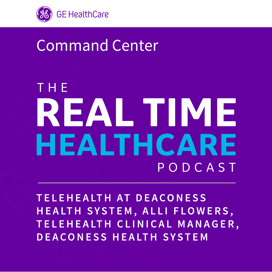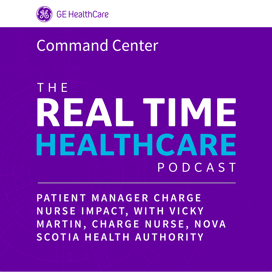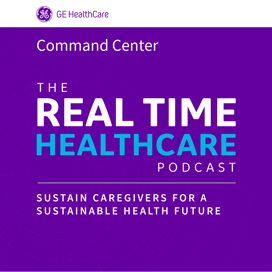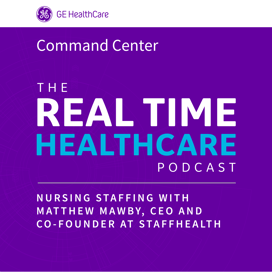#26 - Mary Alice Ragsdale, MSN, MBA, RN VP Operations COO, St. Anthony Hospital COO, Mission Control & Virtual Health Services
Jan 27 · 17:34 min
In this Episode:
Interview with Mary Ragsdale, COO of Virginia Mason Franciscan Health, St. Anthony’s Hospital and Mission Control. Mary shares about their Virtual Hospital and Mission Control programs including governance and outcomes, her favorite GE Tiles, and Virginia Mason Franciscan Health’s administration of the COVID-19 vaccine.
Hear Mary’s perspective on how Mission Control added value for patients and caregivers, by enabling staff to address barriers and concerns on bottlenecks, for which prior to Mission Control, they had no way to recognize. Virginia Mason Franciscan Health’s Mission Control makes the invisible visible and unactionable actionable.
Jeff Terry:
Hello and welcome. I'm Jeff Terry. Very happy today to welcome Mary Ragsdale from Virginia Mason Franciscan Health, which is the recent merger of CHI Franciscan with Virginia Mason Academic Medical Center at Virginia Mason Franciscan. She's also the COO of their Mission Control program and their Virtual Hospital. Hello, Mary, and welcome.
Mary Ragsdale:
Hi Jeff. Thank you.
Jeff Terry:
First question, CHI Franciscan actually had a virtual hospital program several years before creating Mission Control. So can you give us a thumbnail of Virtual Hospital and what that means for you?
Mary Ragsdale:
Absolutely. So our Virtual Hospital program at Virginia Mason Franciscan Health really is designed to be a support for our individuals and our caregivers at the bedside. So for example, we have our virtual ICU that allows us to provide some additional support to our nurses as they care for our most sickest and most critically ill patients.
We have our virtual hospitalist team that allows us to support the physicians at the bedside or in the hospital by doing admissions or rounding on patients. And again, acting as an extra set of eyes and an extra set of support for those team members. We have virtual companion as well, which is how we support with centers. Instead of having one-to-one centers, we have the ability to remote into a room or several rooms and provide that support and teamwork for our caregivers who are taking care of those patients as well.
We also have our contact center in our virtual health services. That is the facility or the department that we use is to make all of our calls through our hospitals, like our cold calls or et cetera. Then finally, we have our consulting nurses in that virtual health system as well. That allows us if a patient wants to call or somebody wants to call, they can provide support for them in a remote way. So ultimately, our virtual health services, our virtual hospital services is an extension, where we have experienced, highly skilled individuals that provide exceptional care to our patients in a remote way and at a remote location.
Jeff Terry:
That's brilliant. I've seen some of that. It's super impressive. So congratulations on all of that work.
Mary Ragsdale:
Thank you.
Jeff Terry:
Then, of course, you built on that. This is where GE got involved and it was our pleasure to add a Mission Control to that. So maybe to start, why did you decide to invest in Mission Control?
Mary Ragsdale:
One of the reasons why we wanted to invest in Mission Control is because we wanted to really improve our access for our patients. When we sat back and really examined ourselves as a system, what we realized is that we really failed to successfully meet the expectations of our patients in regards to getting patients into our different hospitals.
So one of the way that Mission Control really helps us is it allows us to look at ourselves less like a silo and more like the system, so that we can look at all of our access points, and all of our patient points, and all of our opportunities to have a positive impact on a patient through the data, and through high level data that we did not have before. So improving our access was very important and we needed to understand where our gaps were. Mission Control makes that more visible.
We also, as I mentioned, wanted to remove the silos that we talk more as a system. Then we also wanted to look at the quality in how we were delivering the care and how we were creating the experiences for their patients. The only way that you can successfully do that is through data that is updated in a timely manner and data that you can use to take action on.
So Mission Control allows for action, transparency, communication in a different, more effective way, and better patient outcomes, and better patient experience, which is so key in the healthcare industry, particularly when you're trying to make an impact on patients. And either competition is very stiff or the ability and need to grow your market is very important.
Jeff Terry:
Definitely. I should mention for our audience, when you say different access points, eight or nine hospital campuses in CHI Franciscan, so getting patients in and then, of course, distributing them across the health system in the best possible way was a big part of that access mission. [crosstalk 00:04:22]
Mary Ragsdale:
It was absolutely. It was being able to appropriately distribute them was very important. Then being able to really see where we are slow, or where we are ineffective, and not making the right impact for our patients. So if we're going from the ED to an inpatient bed, how are we doing in that way? Are we effective? Are we slow? Are we measuring the impact that we're having on both the patient and the caregiver?
So again, it's the ability to not just look at ourselves as a larger picture, but all the subtleties and all the flows and different ways that a patient goes through our system, are we doing it in a way that's value added for them, that's going to have a positive impact for that patient?
Also, our caregivers, to be quite honest, Mission Control allowed us to address some of the barriers, and the concerns, and the bottlenecks that our caregivers had been raising for several years. Again, they would say this is happening. We had no way of really recognizing and to the extent that it was happening. So data is very powerful in that sense that it makes the invisible visible, and it makes the unactionable actionable. That's really key and very important, particularly when you have either so much time in the day, or you want to prioritize your patient interactions, and not chasing things that are not value added to either that caregiver or that patient.
Jeff Terry:
That's brilliant. Thank you. So you use the word impact. We're fortunate just a couple of days ago, an article ran in a publication about the impact of the program 18 months, and I'll read this. It reported 1,432 excess days eliminated. Treatment expedited for 142 critical care patients. 68 surgeries mitigated. 561 patients enabled to leave the hospital more quickly. Our readers would get more detail to our audience if they're interested in and all that. But I'd love to hear from you as a hardcore operator. How would you characterize that impact?
Mary Ragsdale:
I think the most important impact for me is so much of the time when you're working as an operator, you are measuring your success individually. You are measuring how well your particular hospital is doing, how well your particular finances or whatever is doing. When you're working with the Mission Control, we are all working as a team. So we are working to reduce the boarding that we're having in our hospital and Mission Control has allowed us to do that.
We are working to better distribute the patients throughout our systems, so that one hospital isn't more overwhelmed and we're exhausting the resources at one side, why we have too many resources at another. So Mission Control has allowed us to better work as a team to where we're looking at ourselves more as a team, so that's important.
Then from a financial perspective, it allowed us to improve upon our admissions that we're trying to get into our hospital and our volumes that we're trying to get in. Because we can better manage that and eliminate the barriers that are preventing us from getting our patients in. So it's more transparency, higher volumes, better throughput, and better patient experiences. Then better utilization resources across our system, which again is significant when you again have so few resources as a whole and you're really trying to make that the best impact as a system.
Jeff Terry:
You mentioned breaking down the silos between hospitals. I think it's also fair to say within the hospitals too, helping work more horizontally, is that?
Mary Ragsdale:
Absolutely. When you think about an emergency department, what you sometimes see as an emergency department would be sitting and holding a patient and they will not understand why that inpatient team couldn't take that ED patient up to the floor. So when you look at your Mission Control data, it'll tell you what your barriers are. Are we waiting for an MD consult? Are we waiting for an echo to be done? Are we waiting for a room to open up and be clean? So they begin to understand each other's part in the puzzle and how to support each other in what we're trying to overall accomplish.
So again, that's why you want to remove the barriers to how we communicate. Then that transparency to where things that were again once hidden become very visible. Everybody understands where the bottlenecks is, and everybody has an invested interest in removing those bottlenecks and making us more efficient as not only just a hospital, but as a system. That really is the key to be more efficient as a system to work better as a team so that you make a bigger and better impact on your organization as a whole on your patients and then on your caregivers. That really is key when you look at the work of healthcare and the impact that we're trying to make every day.
Jeff Terry:
You mentioned the datas and seeing with the MD consults and the lab or whatever that is the bottleneck right now for this patient. Of course, that happens in Tiles. I'll share that CHI Franciscan has, I think, nine live Tiles are going live and they range Capacity, Expediter, Census, Forecast, Patient Manager, Advanced Illness. Procedural Growth is going live soon. But I'd love to ask what's your favorite Tile or two?
Mary Ragsdale:
For me, what's favorite for me, if I look at myself from an operator, I like to look at my Boarders Tile. I like to come in and see how many patients are boarding in our ED. Because that tells me a little bit about our length of stay. It tells me a little bit about our throughput. It also tells me about the experience that I'm creating for the patients within my facility. So that's a key one.
In my larger more system being the chief operating officer over the Mission Control, it also tells me how we're doing as a system. Is one facility or two facilities boarding more than others? And if so, then we've got to put some resources there to help offload them or to move some patients out so we can better stabilize that facility. So that is why the Boarders is really key to me.
I also look at Capacity Snapshot because Capacity Snapshot lets me know with my boarding, how am I going to open up? Then how many beds do I have from an ICU perspective, med surg perspective. That helps to also tell me not only from my ED, but from my OR. Am I going to back up in my OR and do I need to put some plans in place to again help that team and move patients through our system?
So those are the two key Tiles that I look at from a perspective. Then I'd say the final one that I really look at is my Discharge Planning Tile. What is preventing me from moving patients outside of our system? What are the barriers? Then how do I get the resources together to work on again making that impact so that we can open up and then move our patients through?
Because not all organizations have the capacity or the volumes that are hitting them like we do. With Virginia Mason CHI Franciscan, we have a lot of volume hitting up against our beds. So how effective we are at moving patients through our system really talks about how effective we're going to be as a system, and how we're going to get out and manage our day to day operations, not just individually, but on a large scale. We have to look at ourselves bigger and globally to make the impact that we need to make.
Jeff Terry:
That makes total sense. It's interesting, obviously COO of Hospital Health System and you have one that's about The front door, Board is your favorite one. That's about the core of the operation that's your favorite. And one that's about getting patients home which is perfect, the whole end to end journey is represented in your favorites.
Mary Ragsdale:
Absolutely.
Jeff Terry:
I also want to ask about governance. The way that you and the team set up governance at CHI Franciscan for the Mission Control, I think it was very innovative. I'll just flag for our audience. One example of that was when we mentioned your title, so you're the COO of a hospital, and you're also the COO of Mission Control, which serves all the hospitals, which is the ultimate way that to make sure Mission Control isn't some ivory tower. If it's not working, you feel it in your day job, if you will. So could you describe that governance structure and your thinking behind it?
Mary Ragsdale:
Absolutely. One of the things that we really wanted to do and Ian Worden, who's our chief operating officer for the system, wanted to make sure is that as we were designing Mission Control, its primary goal is to work for the system and for the operators that are running the system. So we created what we call a Virtual Hospital and Mission Control board. On that board, we have all the hospital operators that are on there. We have our chief medical officer on there. A representative from our care management team is on there and also from our marketing and communication and strategy.
One of the goals that we have within that board is to make sure that Mission Control is functioning in a way to achieve the measures of success that we have set for it. So we need to improve access so we're measuring and meeting every day to talk about is Mission Control doing what it's designed to do, which is improve access? We want to improve the patient experience. Is Mission Control doing what it's designed to do to improve the patient experience?
Now in order for us to improve access and to improve the patient experiences, we also as operators had to agree on workflows, and behaviors, and processes that we were going to change within our organization that allowed us to meet those goals. So in that board, we are looking at each other across the table and hold each other accountable to the agreements that we made. If we're not there or one hospital is straying, than as a collective board, we're asking the questions why.
We're also asking the questions, "Okay, you are outside of what our agreements are, so when can we expect you to get back aligned with what we've agreed to and to help us achieve the outcomes that we want to achieve?" So in some sense, the operators are very much involved in driving the success of the organization through the Mission Control, using the actionable data, but then even more importantly, holding themselves and each other accountable to the agreements that we made. Because if we don't function within our agreements, then our ability to achieve what we said we're going to achieve, the mission control becomes much more difficult. So it's about individual, and system, and facility accountability. That's what the board's role is to hold us accountable to and responsible for what we've agreed to.
Jeff Terry:
From the evidence, it seems to be working, which is terrific. Remind me, I think you have a term, is that right? You're the chair for?
Mary Ragsdale:
I am the chair. So we have a term it's between three to five years as the term as a chair. Then I will rotate off as the chair and then one of the other chief operating officers or team members will rotate on as a chair. So again there, it reduces the ability to get complacent in the role. It always keeps the urgency, and the fresh eyes, and fresh leadership at the helm to make sure again that we're driving and moving in the direction that we want to do ultimately to achieve what we want to achieve, which is to create healthier communities, and have the best patient outcomes and experience that we can for our patients. So that's really the goal.
Jeff Terry:
Brilliant. One last question while we have you, Mary. You mentioned healthier communities, obviously COVID's on everybody's mind. You guys are involved with the vaccine a bit, which I understand is mostly the Pfizer vaccine. Do you mind sharing just where you are with that and what's next for the audience?
Mary Ragsdale:
Absolutely. We are, like everyone else at this point that is distributing this vaccine, in 1A is our phase that we are in. What that means is that we are distributing to our frontline teams like the police, EMS, and et cetera. Then also to our healthcare workers that are on that frontline as well. For us, that's our ED, our emergency department, our ICU, and then our nursing and care teams that are taking direct care of our COVID patients.
So that is what we are doing. We set up our vaccination clinics to be able to do that effectively. We are managing the vaccine as we need to per the protocols to make sure that we are effective. We are also managing the quantity so that there isn't waste. We want to make sure that we use every single dose, and every single patient, every single individual gets that vaccination that needs to.
Once we're done with that, and a proclamation comes forth, then we'll move to 1B, like everybody else. That will open us up more to the community. So we are poised and ready to give community vaccines as well as those that are in the healthcare as well. We are very proud to be a part of the organizations and the team that is distributing that because we recognize the significance of this vaccine and what this means to so many individuals across the world and across the United States.
Jeff Terry:
Here, here. I should say we're proud to serve you and people like you because just the professionalism with which you guys responded to COVID and now handle the vaccine, it's incredible. So I thank you.
Mary Ragsdale:
Thank you very much.
Jeff Terry:
So I think, Mary, thank you so much for making the time today. Great to talk with you. I think with that, I'll close the podcast.







